| Listing 1 - 10 of 18 | << page >> |
Sort by
|
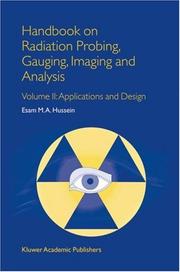
ISBN: 0306484021 1402012942 Year: 2003 Publisher: Dordrecht : Springer Netherlands,
Abstract | Keywords | Export | Availability | Bookmark
 Loading...
Loading...Choose an application
- Reference Manager
- EndNote
- RefWorks (Direct export to RefWorks)
The need for this book arose from my teaching, engineering, and - search experience in the non-power aspects of nuclear technology. The lack of a comprehensive textbook in industrial applications of radiation frustrated my students, who had to resort to a multitude of textbooks and research publications to familiarize themselves with the fundam- tal and practical aspects of radiation technology. As an engineer, I had to acquire the design aspects of radiation devices by trial-and-error, and often by accidental reading of a precious publication. As a researcher and a supervisor of graduate students, I found that the needed literature was either hard to find, or too scattered and diverse. More than once, I discovered that what appeared to be an exciting new idea was an old concept that was tried a few decades earlier during the golden era of “Atom for Peace”. I am hoping, therefore, that this book will serve as a single comprehensive reference source in a growing field that I expect will continue to expand. This book is directed to both neophytes and experts, and is written to combine the old and the new, the basic and the advanced, the simple and the complex. It is anticipated that this book will be of help in - viving older concepts, improving and expanding existing techniques and promoting the development of new ones.
Book
ISBN: 1281006068 9786611006068 008049000X 9780080490007 Year: 2003 Publisher: Amsterdam : Elsevier,
Abstract | Keywords | Export | Availability | Bookmark
 Loading...
Loading...Choose an application
- Reference Manager
- EndNote
- RefWorks (Direct export to RefWorks)
Based on the Institute of Concrete Technology's Advanced Concrete Technology Course, these four volumes are a comprehensive educational and reference resource for the concrete materials technologist. An expert international team of authors from research, academia and industry has been brought together to produce this unique series. Each volume deals with a different aspect of the subject: constituent materials, properties, processes and testing and quality. With worked examples, case studies and illustrations throughout, the books will be a key reference for the concrete specialist for years t
Concrete. --- Concrete construction. --- Chemical & Materials Engineering --- Engineering & Applied Sciences --- Materials Science
Book
ISBN: 9780080490014 0080490018 1281006076 9786611006075 Year: 2003 Publisher: Amsterdam : Elsevier,
Abstract | Keywords | Export | Availability | Bookmark
 Loading...
Loading...Choose an application
- Reference Manager
- EndNote
- RefWorks (Direct export to RefWorks)
Based on the Institute of Concrete Technology's Advanced Concrete Technology Course, these four volumes are a comprehensive educational and reference resource for the concrete materials technologist. An expert international team of authors from research, academia and industry has been brought together to produce this unique series. Each volume deals with a different aspect of the subject: constituent materials, properties, processes and testing and quality. With worked examples, case studies and illustrations throughout, the books will be a key reference for the concrete specialist for years t
Concrete. --- Concrete construction. --- Chemical & Materials Engineering --- Engineering & Applied Sciences --- Materials Science
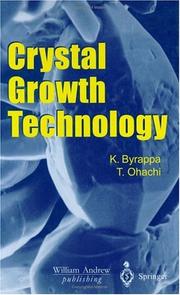
ISBN: 0815514530 9780815514534 3540003673 9783540003670 1591245400 9781591245407 9780815516804 0815516800 9786612013775 1282755234 9786612755231 0080946852 1282013777 Year: 2003 Publisher: Norwich, N.Y. : Berlin ; New York : William Andrew Pub. ; Springer,
Abstract | Keywords | Export | Availability | Bookmark
 Loading...
Loading...Choose an application
- Reference Manager
- EndNote
- RefWorks (Direct export to RefWorks)
Crystals are the unacknowledged pillars of modern technology. The modern technological developments depend greatly on the availability of suitable single crystals, whether it is for lasers, semiconductors, magnetic devices, optical devices, superconductors, telecommunication, etc. In spite of great technological advancements in the recent years, we are still in the early stage with respect to the growth of several important crystals such as diamond, silicon carbide, PZT, gallium nitride, and so on. Unless the science of growing these crystals is understood precisely, it is impossible to grow t
Crystal growth. --- Crystal growth --- Chemical & Materials Engineering --- Engineering & Applied Sciences --- Materials Science --- Crystals --- Crystallization --- Grain boundaries --- Twinning (Crystallography) --- Growth
Book
ISBN: 1280964359 9786610964352 0080469833 0750677341 9780750677349 9780080469836 9781280964350 6610964351 Year: 2003 Publisher: Boston Gulf Professional Pub.
Abstract | Keywords | Export | Availability | Bookmark
 Loading...
Loading...Choose an application
- Reference Manager
- EndNote
- RefWorks (Direct export to RefWorks)
There is much specialist material written about different elements of managing risks of hazardous industries, such as hazard identification, risk analysis, and risk management. Managing Risk and Reliability of Process Plants provides a systematic and integrated coverage of all these elements in sufficient detail for the reader to be able to pursue more detailed study of particular elements or topics from a good appreciation of the whole field. The reader would use this book to keep up to date with new developments and, if they are new to the job, to learn more about the subject. The te
Chemical plants - Management. --- Chemical plants--Management. --- Chemical & Materials Engineering --- Engineering & Applied Sciences --- Chemical Engineering --- Chemical plants --- Management. --- Chemical works --- Chemical engineering --- Factories
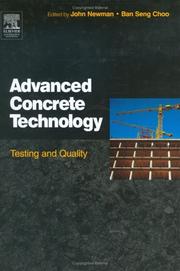
ISBN: 128100605X 9786611006051 0080489982 9780080489988 1282381334 9786612381331 008052656X 9780080490007 9780080490014 9780080489995 008049000X 0080489990 9780750651066 0080490018 Year: 2003 Publisher: Oxford Butterworth-Heinemann
Abstract | Keywords | Export | Availability | Bookmark
 Loading...
Loading...Choose an application
- Reference Manager
- EndNote
- RefWorks (Direct export to RefWorks)
BBased on the Institute of Concrete Technology's advanced course, the Advanced Concrete Technology series is a comprehensive educational and reference resource for the concrete materials technologist. An expert international team of authors from research, academia, and industry have come together to produce this unique reference source.This first volume deals with the constituent materials of concrete. With worked examples, case studies and illustrations throughout, the book will be a key reference for the concrete specialist for years to come.* Expert international auth
Concrete. --- Concrete construction. --- Materials Science --- Chemical & Materials Engineering --- Engineering & Applied Sciences --- Concrete --- Concrete construction --- Building, Concrete --- Concrete building --- Construction, Concrete --- Building --- Beton --- Building materials
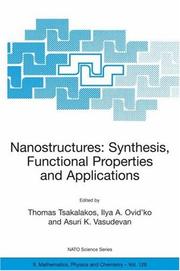

ISBN: 9400710194 1402017529 1402017537 Year: 2003 Volume: v. 128 Publisher: Dordrecht ; Boston ; London Brussels Kluwer Academic Publishers NATO Scientific Affairs Division
Abstract | Keywords | Export | Availability | Bookmark
 Loading...
Loading...Choose an application
- Reference Manager
- EndNote
- RefWorks (Direct export to RefWorks)
The Advanced Study Institute on Synthesis, Functional Properties and Applications of Nanostructures, held at the Knossos Royal Village, Heraklion, Crete, Greece, July 26, 2002 - August 4, 2002, successfully reviewed the state-of-the-art of nanostructures and nanotechnology. It was concluded that Nanotechnology is widely agreed to be the research focus that will lead to the next generation of breakthroughs in science and engineering. There are three cornerstones to the expectation that Nanotechnology will yield revolutionary advances in understanding and application: • Breakthroughs in properties that arise from materials fabricated from the nanoscale. • Synergistic behavior that arise from the combination of disparate types of materials (soft vs. hard, organic vs. inorganic, chemical vs. biological vs. solid state) at the nanoscale. • Exploitation of natural (e.g. chemical and biological) assembly mechanisms that can accomplish structural control at the nanoscale. It is expected that this will lead to paradigms for assembling bio-inspired functional systems that accomplish desirable properties that are either unavailable or prohibitively expensive using top-down approaches.
Chemical & Materials Engineering --- Engineering & Applied Sciences --- Materials Science --- Nanostructured materials --- Molecular electronics --- Nanotechnology --- Nanomatériaux --- Electronique moléculaire --- Nanotechnologie --- Congresses --- Congresses. --- Congrès --- Materials science. --- Characterization and Evaluation of Materials. --- Material science --- Physical sciences
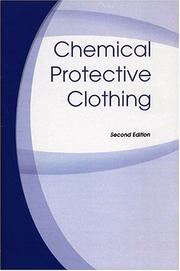
ISBN: 1935082752 1621987906 9781935082750 9781621987901 1931504466 9781931504461 Year: 2003 Publisher: Fairfax, VA
Abstract | Keywords | Export | Availability | Bookmark
 Loading...
Loading...Choose an application
- Reference Manager
- EndNote
- RefWorks (Direct export to RefWorks)
Chemical engineering --- Protective clothing --- Chemical & Materials Engineering --- Engineering & Applied Sciences --- Chemical Engineering --- Clothing, Protective --- Personal protective equipment --- Safety clothing --- Clothing and dress --- Safety measures --- PPE (Personal protective equipment) --- Industrial safety --- Survival and emergency equipment --- Equipment and supplies
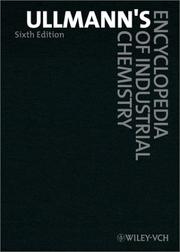
ISBN: 3527329439 3527303855 3527306730 9783527306732 9783527339884 Year: 2003 Publisher: Weinheim, Germany : Wiley-VCH,
Abstract | Keywords | Export | Availability | Bookmark
 Loading...
Loading...Choose an application
- Reference Manager
- EndNote
- RefWorks (Direct export to RefWorks)
A reference work detailing the science and technology in all areas of industrial chemistry. Fully international in scope and coverage and published in the English language. It contains nearly 1000 major articles. With more than 16 million words, nearly 10,000 tables, 30,000 figures, and innumerable literature sources and cross-references, Also includes full text index, author index, CAS registry number index, and keyword index.
Chemistry, Technical --- Chemical engineering --- Chemical Engineering --- Chemical & Materials Engineering --- Engineering & Applied Sciences --- Chemistry, Industrial --- Engineering, Chemical --- Industrial chemistry --- Engineering --- Metallurgy --- Chemical technology --- Technical chemistry --- Chemistry --- Technology --- Chemistry, Analytic --- Chemicals
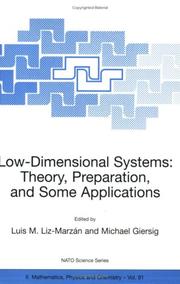
ISBN: 940100143X 1402011695 1402011687 Year: 2003 Volume: v. 91 Publisher: Dordrecht ; Boston ; London Brussels Kluwer Academic Publishers NATO Scientific Affairs Division
Abstract | Keywords | Export | Availability | Bookmark
 Loading...
Loading...Choose an application
- Reference Manager
- EndNote
- RefWorks (Direct export to RefWorks)
This volume contains papers presented at the NATO Advanced Research Workshop (ARW) Dynamic Interactions in Quantum Dot Systems held at Hotel Atrium in Puszczykowo, near Poznan, Poland, May 16-19,2002. The term low-dimensional systems, which is used in the title of this volume, refers to those systems which contain at least one dimension that is intermediate between those characteristic ofatoms/molecules and those ofthe bulk material. Depending on how many dimensions lay within this range, we generally speak of quantum wells, quantum wires, and quantum dots. As such an intermediate state, some properties of low-dimensional systems are very different to those of their molecular and bulk counterparts. These properties generally include optical, electronic, and magnetic properties, and all these are partially covered in this book. The main goal of the workshop was to discuss the actual state of the art in the broad area ofnanotechnology. The initial focus was on the innovative synthesis of nanomaterials and their properties such as: quantum size effects, superparamagnetism, or field emission. These topics lead us into the various field based interactions including plasmon- magnetic spin- and exciton coupling. The newer, more sophisticated methods for characterization of nanomaterials were discussed, as well as the methods for possible industrial applications. In general, chemists and physicists, as well as experts on both theory and experiments on nanosized regime structures were brought together, to discuss the general phenomena underlying their fields ofinterest from different points ofview.
Nanotechnology --- Nanostructured materials --- Engineering & Applied Sciences --- Technology - General --- Chemical & Materials Engineering --- Materials Science --- Nanotechnologie --- Nanomatériaux --- Congresses. --- Congresses --- Congrès --- Materials science. --- Nanotechnology. --- Physical chemistry. --- Materials Science, general. --- Nanotechnology and Microengineering. --- Characterization and Evaluation of Materials. --- Physical Chemistry. --- Molecular technology --- Nanoscale technology --- High technology --- Material science --- Physical sciences --- Chemistry, Theoretical --- Physical chemistry --- Theoretical chemistry --- Chemistry
| Listing 1 - 10 of 18 | << page >> |
Sort by
|

 Search
Search Feedback
Feedback About UniCat
About UniCat  Help
Help News
News